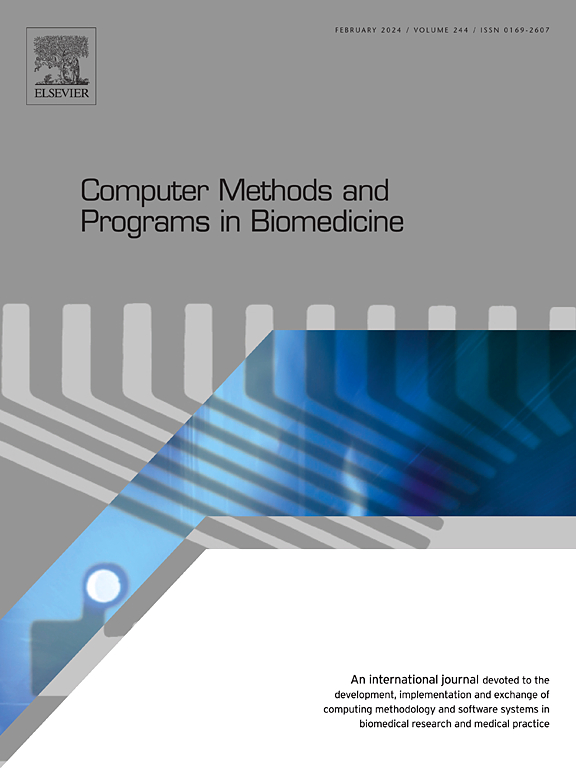法医病理学中的人工智能:多器官死后病理学用于估计死后时间间隔
IF 4.9
2区 医学
Q1 COMPUTER SCIENCE, INTERDISCIPLINARY APPLICATIONS
引用次数: 0
摘要
在法医调查中,准确估计死亡时间间隔是至关重要的。病理学通过利用全幻灯片图像作为临床疾病诊断和预后的新数据模式,呈现出有希望的进步。该技术在法医死后图像分析中的扩展应用有望产生死后病理学作为一个重要的分支领域。目的建立病理学三级分级策略分析死后组织学图像数据,建立多器官综合模型估计死后时间间隔,为死后病理学奠定基础。方法对12头巴马小型猪实施安乐死,分别于死后6、24、48和96 h采集肝、肾和骨骼肌组织。苏木精和伊红染色的整张切片图像被分割成512 × 512像素的小块。使用Otsu阈值法排除低质量斑块,并使用Vahadane算法进行颜色归一化以最小化染色变异性。深度学习模型使用迁移学习在补丁级数据上进行训练,并使用Grad-CAM评估其可解释性。通过特定器官的深度特征聚合和机器学习模型获得滑动级预测,而使用将上述机器学习模型和逻辑回归相结合的堆叠集成开发了多器官集成模型。另外4头猪被引入进行多器官综合个体水平的外部验证。结果densenet121在肝脏和肾脏组织中表现较好,而VGG16在骨骼肌组织中表现最好。这些模型分别被命名为死后肝网、死后肾网和死后肌肉网,并用于从图像中提取病理特征。在这些特征向量上训练的幻灯片级模型的准确率分别为81.25%(肝脏)、87.5%(肾脏)和62.5%(肌肉)。将这三种滑动水平模型的概率输出进行叠加,得到的多器官综合个体水平的内外部测试准确率分别为93.75%和87.5%。结论本研究证明了病理学和深度学习在估计死后时间间隔方面的潜力。所提出的三层框架有效地整合了多器官特征,引入了全切片图像作为一种新的模式,并为尸检间隔估计提供了一种创新的策略。本文章由计算机程序翻译,如有差异,请以英文原文为准。
Artificial intelligence in forensic pathology: Multi-organ postmortem pathomics for estimating postmortem interval
Background
Accurate estimation of the postmortem interval is crucial in forensic investigations. Pathomics presents a promising advancement by leveraging whole-slide images as a novel data modality for the diagnosis and prognosis of diseases in clinical situations. The extended application of this technology in forensic postmortem image analysis is expected to give rise to postmortem pathomics as an important subfield.
Objective
This study aimed to develop a three-level hierarchical strategy using pathomics to analyze postmortem histological images data, develop multi-organ integrated model for the postmortem interval estimation, and lay the foundation for postmortem pathomics.
Methods
Twelve Bama miniature pigs were euthanized, and liver, kidney, and skeletal muscle tissues were collected at 6, 24, 48, and 96 h postmortem. Hematoxylin and eosin stained whole slide images were divided into 512 × 512 pixel patches. Low-quality patches were excluded using Otsu thresholding, and color normalization was applied using the Vahadane algorithm to minimize staining variability. Deep learning models were trained on patch-level data using transfer learning and evaluated for interpretability with Grad-CAM. Slide-level predictions were obtained via organ-specific deep feature aggregation and machine learning models, while a multi-organ integrated model was developed using a stacking ensemble combining above machine learning models and a logistic regression. Four additional pigs were introduced for external validation at the multi-organ integrated individual-level.
Results
DenseNet121 demonstrated superior performance for liver and kidney, while VGG16 performed best for skeletal muscle tissue. These models were designated as postmortem-liver-net, postmortem-kidney-net, and postmortem-muscle-net, respectively, and employed to extract pathomics features from images. Slide-level models trained on these features vectors achieved accuracies of 81.25% (liver), 87.5% (kidney), and 62.5% (muscle). A stacking model integrating probability output of these three slide-level models achieved internal and external test accuracies at multi-organ integrated individual-level of 93.75% and 87.5%, respectively.
Conclusion
This study demonstrated the potential of pathomics and deep learning for postmortem interval estimation. The proposed three-level framework effectively integrated multi-organ features, introducing whole-slide images as a novel modality and offering an innovative strategy for postmortem interval estimation.
求助全文
通过发布文献求助,成功后即可免费获取论文全文。
去求助
来源期刊

Computer methods and programs in biomedicine
工程技术-工程:生物医学
CiteScore
12.30
自引率
6.60%
发文量
601
审稿时长
135 days
期刊介绍:
To encourage the development of formal computing methods, and their application in biomedical research and medical practice, by illustration of fundamental principles in biomedical informatics research; to stimulate basic research into application software design; to report the state of research of biomedical information processing projects; to report new computer methodologies applied in biomedical areas; the eventual distribution of demonstrable software to avoid duplication of effort; to provide a forum for discussion and improvement of existing software; to optimize contact between national organizations and regional user groups by promoting an international exchange of information on formal methods, standards and software in biomedicine.
Computer Methods and Programs in Biomedicine covers computing methodology and software systems derived from computing science for implementation in all aspects of biomedical research and medical practice. It is designed to serve: biochemists; biologists; geneticists; immunologists; neuroscientists; pharmacologists; toxicologists; clinicians; epidemiologists; psychiatrists; psychologists; cardiologists; chemists; (radio)physicists; computer scientists; programmers and systems analysts; biomedical, clinical, electrical and other engineers; teachers of medical informatics and users of educational software.
 求助内容:
求助内容: 应助结果提醒方式:
应助结果提醒方式:


